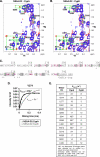Hepatitis C virus NS5A protein is a substrate for the peptidyl-prolyl cis/trans isomerase activity of cyclophilins A and B
- PMID: 19297321
- PMCID: PMC2679460
- DOI: 10.1074/jbc.M809244200
Hepatitis C virus NS5A protein is a substrate for the peptidyl-prolyl cis/trans isomerase activity of cyclophilins A and B
Abstract
We report here a biochemical and structural characterization of domain 2 of the nonstructural 5A protein (NS5A) from the JFH1 Hepatitis C virus strain and its interactions with cyclophilins A and B (CypA and CypB). Gel filtration chromatography, circular dichroism spectroscopy, and finally NMR spectroscopy all indicate the natively unfolded nature of this NS5A-D2 domain. Because mutations in this domain have been linked to cyclosporin A resistance, we used NMR spectroscopy to investigate potential interactions between NS5A-D2 and cellular CypA and CypB. We observed a direct molecular interaction between NS5A-D2 and both cyclophilins. The interaction surface on the cyclophilins corresponds to their active site, whereas on NS5A-D2, it proved to be distributed over the many proline residues of the domain. NMR heteronuclear exchange spectroscopy yielded direct evidence that many proline residues in NS5A-D2 form a valid substrate for the enzymatic peptidyl-prolyl cis/trans isomerase (PPIase) activity of CypA and CypB.
Figures






Similar articles
-
Domain 3 of NS5A protein from the hepatitis C virus has intrinsic alpha-helical propensity and is a substrate of cyclophilin A.J Biol Chem. 2011 Jun 10;286(23):20441-54. doi: 10.1074/jbc.M110.182436. Epub 2011 Apr 13. J Biol Chem. 2011. PMID: 21489988 Free PMC article.
-
Hepatitis C virus NS5B and host cyclophilin A share a common binding site on NS5A.J Biol Chem. 2012 Dec 28;287(53):44249-60. doi: 10.1074/jbc.M112.392209. Epub 2012 Nov 14. J Biol Chem. 2012. PMID: 23152499 Free PMC article.
-
The domain 2 of the HCV NS5A protein is intrinsically unstructured.Protein Pept Lett. 2010 Aug;17(8):1012-8. doi: 10.2174/092986610791498920. Protein Pept Lett. 2010. PMID: 20450484
-
Cyclophilin inhibitors for the treatment of HCV infection.Curr Opin Investig Drugs. 2010 Aug;11(8):911-8. Curr Opin Investig Drugs. 2010. PMID: 20721833 Review.
-
Structural and Functional Insights into Human Nuclear Cyclophilins.Biomolecules. 2018 Dec 4;8(4):161. doi: 10.3390/biom8040161. Biomolecules. 2018. PMID: 30518120 Free PMC article. Review.
Cited by
-
The molecular and structural basis of advanced antiviral therapy for hepatitis C virus infection.Nat Rev Microbiol. 2013 Jul;11(7):482-96. doi: 10.1038/nrmicro3046. Epub 2013 Jun 10. Nat Rev Microbiol. 2013. PMID: 23748342 Review.
-
Cyclophilins as modulators of viral replication.Viruses. 2013 Jul 11;5(7):1684-701. doi: 10.3390/v5071684. Viruses. 2013. PMID: 23852270 Free PMC article. Review.
-
Curing a viral infection by targeting the host: the example of cyclophilin inhibitors.Antiviral Res. 2013 Jul;99(1):68-77. doi: 10.1016/j.antiviral.2013.03.020. Epub 2013 Apr 8. Antiviral Res. 2013. PMID: 23578729 Free PMC article. Review.
-
Emerging Roles of Cyclophilin A in Regulating Viral Cloaking.Front Microbiol. 2022 Feb 15;13:828078. doi: 10.3389/fmicb.2022.828078. eCollection 2022. Front Microbiol. 2022. PMID: 35242122 Free PMC article. Review.
-
Symmetric Anti-HCV Agents: Synthesis, Antiviral Properties, and Conformational Aspects of Core Scaffolds.ACS Omega. 2019 Jul 1;4(7):11440-11454. doi: 10.1021/acsomega.9b01242. eCollection 2019 Jul 31. ACS Omega. 2019. PMID: 31460249 Free PMC article.
References
-
- National Institutes of Health (2002) Hepatology 36 Suppl. 1, S2-S20
-
- Appel, N., Schaller, T., Penin, F., and Bartenschlager, R. (2006) J. Biol. Chem. 281 9833-9836 - PubMed
-
- Moradpour, D., Penin, F., and Rice, C. M. (2007) Nat. Rev. 5 453-463 - PubMed
-
- Lohmann, V., Korner, F., Koch, J., Herian, U., Theilmann, L., and Bartenschlager, R. (1999) Science 285 110-113 - PubMed
Publication types
MeSH terms
Substances
LinkOut - more resources
Full Text Sources
Other Literature Sources

